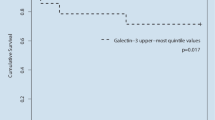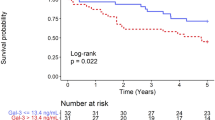Abstract
Background
Galectin-3 (Gal-3) is a recently discovered marker for myocardial fibrosis and elevated levels are associated with an impaired outcome after short-term follow-up in heart failure (HF) patients. However, whether Gal-3 is related to cardiac remodeling and outcome after long-term follow-up is unknown. Therefore, we determined the utility of Gal-3 as a novel biomarker for left ventricular remodeling and long-term outcome in patients with severe chronic HF.
Methods and results
A total of 240 HF patients with New York Heart Association (NYHA) Class III and IV were included. Patients were followed for 8.7 ± 1 years, had a mean age of 71 ± 0.6 years and 73 % of the study population was male. Circulating levels of NT-proBNP and Gal-3 were measured. Serial echocardiography was performed at baseline and at 3 months. At baseline median left ventricular end-diastolic volume (LVEDV) was 267 mL [interquartile range 232–322]. Patients were divided into three groups according to the change in LVEDV. Patients in whom the LVEDV decreased over time had significant lower levels of Gal-3 at entry compared to patients in whom the LVEDV was stable or increased (14.7 vs. 17.9 vs. 19.0 ng/mL; p = 0.004 for trend), whereas no significant differences were seen in levels of NT-proBNP (p = 0.33). Multivariate linear regression analyses revealed that Gal-3 levels were positively correlated to change in LVEDV (p = 0.007). In addition, Gal-3 was a significant predictor of mortality after long-term follow-up (p = 0.001).
Conclusion
Gal-3 is associated with left ventricular remodeling determined by serial echocardiography and predicts long-term mortality in patients with severe chronic HF.



Similar content being viewed by others
Abbreviations
- DEAL-HF:
-
Deventer Alkmaar Heart Failure study
- EF:
-
Ejection fraction
- Gal-3:
-
Galectin-3
- HF:
-
Heart failure
- HFpEF:
-
Heart failure with a preserved ejection fraction
- HFrEF:
-
Heart failure with a reduced ejection fraction
- LVEDV:
-
Left ventricle end-diastolic volume
- LVESV:
-
Left ventricular end-systolic volume
- NPs:
-
Natriuretic peptides
- NT-proBNP:
-
N-terminal part pro brain natriuretic peptide
- ROC:
-
Receiver operating characteristic
References
Cohn JN, Ferrari R, Sharpe N (2000) Cardiac remodeling–concepts and clinical implications: a consensus paper from an international forum on cardiac remodeling. Behalf of an International Forum on Cardiac Remodeling. J Am Coll Cardiol 35:569–582
Dickstein K et al (2008) ESC Guidelines for the diagnosis and treatment of acute and chronic heart failure 2008: the Task Force for the Diagnosis and Treatment of Acute and Chronic Heart Failure 2008 of the European Society of Cardiology. Developed in collaboration with the Heart Failure Association of the ESC (HFA) and endorsed by the European Society of Intensive Care Medicine (ESICM). Eur Heart J 29:2388–2442
Franke J et al (2011) Is there an additional benefit of serial NT-proBNP measurements in patients with stable chronic heart failure receiving individually optimized therapy? Clin Res Cardiol 100:1059–1067
Binder A et al (2010) Limited value of brain natriuretic peptide as a prognostic marker in acute heart failure—a meta-analysis. Int J Cardiol 145:540–541
Emdin M, Vittorini S, Passino C, Clerico A (2009) Old and new biomarkers of heart failure. Eur J Heart Fail 11:331–335
Battistoni A, Rubattu S, Volpe M (2012) Circulating biomarkers with preventive, diagnostic and prognostic implications in cardiovascular diseases. Int J Cardiol 157(2):160–168
Böhm M et al (2011) Biomarkers: optimizing treatment guidance in heart failure. Clin Res Cardiol 100:973–981
Sharma UC et al (2004) Galectin-3 marks activated macrophages in failure-prone hypertrophied hearts and contributes to cardiac dysfunction. Circulation 110:3121–3128
de Boer RA, Yu L, van Veldhuisen DJ (2010) Galectin-3 in cardiac remodeling and heart failure. Curr Heart Fail Rep 7:1–8
Liu FT et al (1995) Expression and function of galectin-3, a beta-galactoside-binding lectin, in human monocytes and macrophages. Am J Pathol 147:1016–1028
van Kimmenade RR et al (2006) Utility of amino-terminal pro-brain natriuretic peptide, galectin-3, and apelin for the evaluation of patients with acute heart failure. J Am Coll Cardiol 48:1217–1224
Shah RV, Chen-Tournoux AA, Picard MH, van Kimmenade RRJ, Januzzi JL (2010) Galectin-3, cardiac structure and function, and long-term mortality in patients with acutely decompensated heart failure. Eur J Heart Fail 12:826–832
van Veldhuisen DJ et al (2009) Clinical and prognostic value of galectin-3, a novel fibrosis-associated biomarker, in patients with chronic heart failure. J Card Fail 15:814
Milting H et al (2008) Plasma biomarkers of myocardial fibrosis and remodeling in terminal heart failure patients supported by mechanical circulatory support devices. J Heart Lung Transplant 27:589–596
Ueland T et al (2011) Galectin-3 in heart failure: high levels are associated with all-cause mortality. Int J Cardiol 150:361–364
Bruggink-André de la Porte PWF et al (2005) Heart failure programmes in countries with a primary care-based health care system. Are additional trials necessary? Design of the DEAL-HF study. Eur J Heart Fail 7:910–920
de la Porte PW et al (2007) Added value of a physician-and-nurse-directed heart failure clinic: results from the Deventer-Alkmaar heart failure study. Heart 93:819–825
Remme W (2001) Guidelines for the diagnosis and treatment of chronic heart failure. Eur Heart J 22:1527–1560
Teichholz LE, Kreulen T, Herman MV, Gorlin R (1976) Problems in echocardiographic volume determinations: echocardiographic-angiographic correlations in the presence of absence of asynergy. Am J Cardiol 37:7–11
van Bommel RJ et al (2009) Characteristics of heart failure patients associated with good and poor response to cardiac resynchronization therapy: a PROSPECT (Predictors of Response to CRT) sub-analysis. Eur Heart J 30:2470–2477
Nicolosi GL et al (2009) Effects of perindopril on cardiac remodelling and prognostic value of pre-discharge quantitative echocardiographic parameters in elderly patients after acute myocardial infarction: the PREAMI echo sub-study. Eur Heart J 30:1656–1665
Christenson RH et al (2010) Multi-center determination of galectin-3 assay performance characteristics: Anatomy of a novel assay for use in heart failure. Clin Biochem 43:683–690
Smilde TDJ, van Veldhuisen DJ, Navis G, Voors AA, Hillege HL (2006) Drawbacks and prognostic value of formulas estimating renal function in patients with chronic heart failure and systolic dysfunction. Circulation 114:1572–1580
de Boer RA, Pinto YM, van Veldhuisen DJ (2003) The imbalance between oxygen demand and supply as a potential mechanism in the pathophysiology of heart failure: the role of microvascular growth and abnormalities. Microcirculation 10:113–126
Lok DJA et al (2010) Prognostic value of galectin-3, a novel marker of fibrosis, in patients with chronic heart failure: data from the DEAL-HF study. Clin Res Cardiol 99:323–328
Clerico A et al (1998) Circulating levels of cardiac natriuretic peptides (ANP and BNP) measured by highly sensitive and specific immunoradiometric assays in normal subjects and in patients with different degrees of heart failure. J Endocrinol Invest 21:170–179
de Boer RA et al (2011) Predictive value of plasma galectin-3 levels in heart failure with reduced and preserved ejection fraction. Ann Med 43:60–68
Acknowledgments
BG Medicine, Inc. has certain rights related to Galectin-3 measurements. BG Medicine, Inc. provided an unrestricted research grant to the Department of Cardiology of the University Medical Center Groningen, that employs dr. van der Meer, Lipsic, de Boer and van Veldhuisen. Dr. van Veldhuisen and de Boer have received consultancy and speaker’s fees from BG Medicine, Inc. The Deventer Cardiology Research department received an unrestricted research grant from BG Medicine Inc.
Author information
Authors and Affiliations
Corresponding author
Rights and permissions
About this article
Cite this article
Lok, D.J., Lok, S.I., Bruggink-André de la Porte, P.W. et al. Galectin-3 is an independent marker for ventricular remodeling and mortality in patients with chronic heart failure. Clin Res Cardiol 102, 103–110 (2013). https://doi.org/10.1007/s00392-012-0500-y
Received:
Accepted:
Published:
Issue Date:
DOI: https://doi.org/10.1007/s00392-012-0500-y




